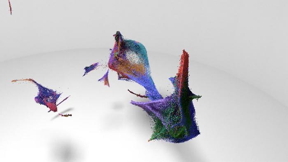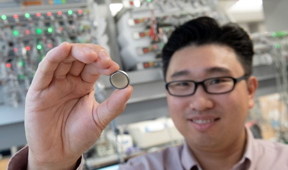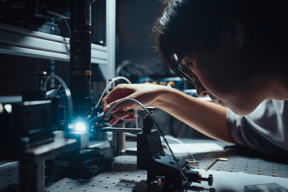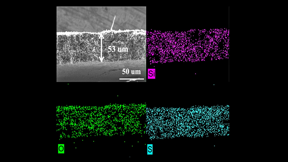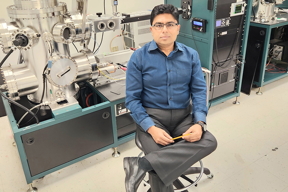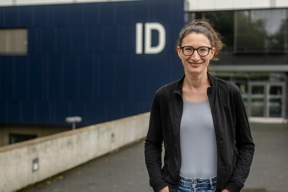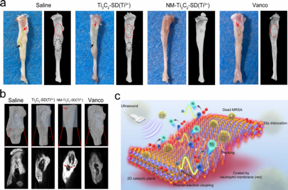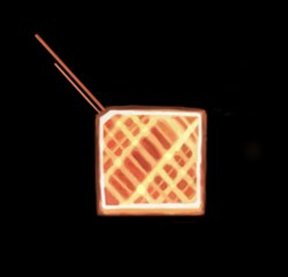Home > Press > Unlocking quantum potential: Harnessing high-dimensional quantum states with QDs and OAM: Generation of nearly deterministic OAM-based entangled states offers a bridge between photonic technologies for quantum advancements
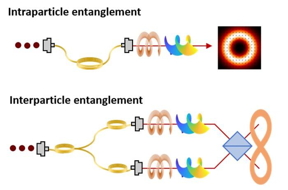 |
| Conceptual scheme of the proposed protocol. Manipulating the polarization and OAM of single photons generated from a QD source in a nearly deterministic fashion, intraparticle entangled states are generated by making the two degrees of freedom interact through a q-plate. In the interparticle regime, two photons characterized by specific states in the hybrid space composed of polarization and OAM interfere using a beam-splitter. Post-selecting on the coincidence counts, a probabilistic entangling gate has been implemented. CREDIT Alessia Suprano. |
Abstract:
Quantum technology's future rests on the exploitation of fascinating quantum mechanics concepts — such as high-dimensional quantum states. Think of these as states basic ingredients of quantum information science and quantum tech. To manipulate these states, scientists have turned to light, specifically a property called orbital angular momentum (OAM), which deals with how light twists and turns in space. Here's a catch: making super bright single photons with OAM in a deterministic fashion has been a tough nut to crack.
Unlocking quantum potential: Harnessing high-dimensional quantum states with QDs and OAM: Generation of nearly deterministic OAM-based entangled states offers a bridge between photonic technologies for quantum advancements
Bellingham, WA | Posted on September 8th, 2023Now, enter quantum dots (QDs), tiny particles with big potential. A team of researchers from Sapienza University of Rome, Paris-Saclay University, and University of Naples Federico II combined the features of OAM with those of QDs to create a bridge between two cutting-edge technologies. Their results are published in the peer-reviewed Gold Open Access journal Advanced Photonics.
So, where is the innovation? This bridge they've built can be flexibly used for two goals. First, it can make pure single photons that are entangled within the OAM-polarization space, and the researchers can count them directly. Second, this bridge can also make pairs of photons that are strongly correlated in the quantum world. They're entangled, so that each single photon state cannot be described independently of the other, even when they're far apart. This is a big deal for quantum communication and encryption.
This new platform has the potential to create hybrid entanglement states both within and between particles, all belonging to high-dimensional Hilbert spaces. On one hand, the team has achieved the generation of pure single photons, whose quantum states exhibit nonseparability within the hybrid OAM-polarization domain. By exploiting an almost deterministic quantum source in combination with a q-plate — a device capable of adjusting the OAM value based on single photon polarization — the researchers can directly validate these states through single-photon counts, thereby avoiding the need for a heralding process and enhancing the rate of generation.
On the other hand, the team also employs the concept of indistinguishability within single photons as a resource to generate pairs of single photons that possess entanglement within the hybrid OAM-polarization space. According to Professor Fabio Sciarrino, head of Quantum Information Lab in the Department of Physics of Sapienza University of Rome, “The proposed flexible scheme represents a step forward in high-dimensional multiphoton experiments, and it could provide an import platform for both fundamental investigations and quantum photonic applications.”
In simple terms, this research is a leap in our quest for better quantum technologies. It's like connecting two major cities. This connection opens exciting possibilities for quantum computing, communication, and much more. So, keep an eye on this — it's not just science; it's the future.
####
For more information, please click here
Contacts:
Daneet Steffens
SPIE--International Society for Optics and Photonics
Office: 360-685-5478
Copyright © SPIE--International Society for Optics and Photonics
If you have a comment, please Contact us.Issuers of news releases, not 7th Wave, Inc. or Nanotechnology Now, are solely responsible for the accuracy of the content.
| Related Links |
| Related News Press |
News and information
![]() New compound unleashes the immune system on metastases September 8th, 2023
New compound unleashes the immune system on metastases September 8th, 2023
![]() Machine learning contributes to better quantum error correction September 8th, 2023
Machine learning contributes to better quantum error correction September 8th, 2023
![]() Tests find no free-standing nanotubes released from tire tread wear September 8th, 2023
Tests find no free-standing nanotubes released from tire tread wear September 8th, 2023
![]() Quantum powers researchers to see the unseen September 8th, 2023
Quantum powers researchers to see the unseen September 8th, 2023
Quantum Physics
![]() Quantum powers researchers to see the unseen September 8th, 2023
Quantum powers researchers to see the unseen September 8th, 2023
![]() A quantum leap in mechanical oscillator technology August 11th, 2023
A quantum leap in mechanical oscillator technology August 11th, 2023
Physics
Possible Futures
![]() New compound unleashes the immune system on metastases September 8th, 2023
New compound unleashes the immune system on metastases September 8th, 2023
![]() Machine learning contributes to better quantum error correction September 8th, 2023
Machine learning contributes to better quantum error correction September 8th, 2023
![]() Tests find no free-standing nanotubes released from tire tread wear September 8th, 2023
Tests find no free-standing nanotubes released from tire tread wear September 8th, 2023
Quantum Computing
![]() Training quantum computers: physicists win prestigious IBM Award September 8th, 2023
Training quantum computers: physicists win prestigious IBM Award September 8th, 2023
![]() Machine learning contributes to better quantum error correction September 8th, 2023
Machine learning contributes to better quantum error correction September 8th, 2023
Discoveries
![]() Electronic detection of DNA nanoballs enables simple pathogen detection Peer-Reviewed Publication September 8th, 2023
Electronic detection of DNA nanoballs enables simple pathogen detection Peer-Reviewed Publication September 8th, 2023
![]() Training quantum computers: physicists win prestigious IBM Award September 8th, 2023
Training quantum computers: physicists win prestigious IBM Award September 8th, 2023
![]() Tests find no free-standing nanotubes released from tire tread wear September 8th, 2023
Tests find no free-standing nanotubes released from tire tread wear September 8th, 2023
![]() Quantum powers researchers to see the unseen September 8th, 2023
Quantum powers researchers to see the unseen September 8th, 2023
Announcements
![]() Electronic detection of DNA nanoballs enables simple pathogen detection Peer-Reviewed Publication September 8th, 2023
Electronic detection of DNA nanoballs enables simple pathogen detection Peer-Reviewed Publication September 8th, 2023
![]() Training quantum computers: physicists win prestigious IBM Award September 8th, 2023
Training quantum computers: physicists win prestigious IBM Award September 8th, 2023
![]() Machine learning contributes to better quantum error correction September 8th, 2023
Machine learning contributes to better quantum error correction September 8th, 2023
![]() Tests find no free-standing nanotubes released from tire tread wear September 8th, 2023
Tests find no free-standing nanotubes released from tire tread wear September 8th, 2023
Interviews/Book Reviews/Essays/Reports/Podcasts/Journals/White papers/Posters
![]() Electronic detection of DNA nanoballs enables simple pathogen detection Peer-Reviewed Publication September 8th, 2023
Electronic detection of DNA nanoballs enables simple pathogen detection Peer-Reviewed Publication September 8th, 2023
![]() New compound unleashes the immune system on metastases September 8th, 2023
New compound unleashes the immune system on metastases September 8th, 2023
Photonics/Optics/Lasers
![]() University of Chicago scientists invent smallest known way to guide light: 2D optical waveguides could point way to new technology August 11th, 2023
University of Chicago scientists invent smallest known way to guide light: 2D optical waveguides could point way to new technology August 11th, 2023
![]() Ultrafast lasers for materials processing August 11th, 2023
Ultrafast lasers for materials processing August 11th, 2023
![]() Femtosecond laser technique births "dancing microrobots": USTC's breakthrough in multi-material microfabrication August 11th, 2023
Femtosecond laser technique births "dancing microrobots": USTC's breakthrough in multi-material microfabrication August 11th, 2023
- SEO Powered Content & PR Distribution. Get Amplified Today.
- PlatoData.Network Vertical Generative Ai. Empower Yourself. Access Here.
- PlatoAiStream. Web3 Intelligence. Knowledge Amplified. Access Here.
- PlatoESG. Automotive / EVs, Carbon, CleanTech, Energy, Environment, Solar, Waste Management. Access Here.
- PlatoHealth. Biotech and Clinical Trials Intelligence. Access Here.
- ChartPrime. Elevate your Trading Game with ChartPrime. Access Here.
- BlockOffsets. Modernizing Environmental Offset Ownership. Access Here.
- Source: http://www.nanotech-now.com/news.cgi?story_id=57393
- :has
- :is
- :not
- :where
- 10
- 2023
- 21st
- 29
- 2D
- 30th
- 7th
- 8
- 8th
- a
- access
- According
- accuracy
- achieved
- advanced
- advancements
- AL
- All
- almost
- also
- an
- and
- Angular
- apart
- Application
- applications
- ARE
- AS
- AUGUST
- avoiding
- based
- basic
- BE
- been
- Better
- between
- Big
- both
- breakthrough
- BRIDGE
- Bright
- built
- by
- called
- CAN
- Cancer
- cannot
- capable
- Catch
- Center
- CGI
- characteristic
- characterized
- chicago
- chip
- Cities
- click
- coincidence
- COM
- combination
- combined
- comment
- Communication
- complex
- composed
- Compound
- computers
- computing
- concept
- concepts
- conceptual
- Confirm
- Connecting
- connection
- content
- contributes
- correlated
- could
- crack
- create
- credit
- crucial
- cutting-edge
- Cutting-Edge Technologies
- dance
- Dancing
- deal
- Deals
- Department
- described
- details
- Detection
- develop
- device
- diagnosis
- dimensions
- directly
- discover
- dna
- domain
- DOT
- dynamics
- E&T
- each
- Early
- Edge
- Electronic
- employs
- enables
- encryption
- end
- enhancing
- Enter
- error
- Ether (ETH)
- Even
- exciting
- exhibit
- experiments
- Explain
- exploitation
- eye
- far
- fascinating
- Fashion
- Features
- Federico
- Find
- First
- flexible
- flexibly
- For
- Forward
- Freedom
- from
- full
- fundamental
- future
- generate
- generated
- generation
- gif
- Goals
- Gold
- guide
- hand
- Harnessing
- Have
- head
- help
- heralding
- here
- High
- How
- http
- HTTPS
- human
- Hybrid
- IBM
- if
- ii
- immune
- Immune system
- implemented
- import
- in
- Inc.
- independently
- information
- ingredients
- Innovation
- interact
- interfere
- Investigations
- IT
- journal
- jpg
- July
- june
- just
- Keep
- known
- lab
- laser
- lasers
- Leap
- learning
- light
- like
- links
- made
- major
- make
- Making
- manipulating
- materials
- mechanical
- mechanics
- Momentum
- more
- much
- multiphoton
- nanotechnology
- Natural
- nearly
- Need
- net
- New
- New Platform
- news
- nexus
- no
- Noise
- novel
- now
- nuclear
- of
- Offers
- on
- ONE
- open
- opens
- optics
- or
- original
- Other
- our
- pairs
- peer-reviewed
- Photons
- PHP
- Physics
- platform
- plato
- Plato Data Intelligence
- PlatoData
- please
- Point
- possess
- possibilities
- Post
- posted
- potential
- powers
- press
- Press Release
- prestigious
- process
- Professor
- property
- proposed
- protocol
- provide
- published
- Quantum
- quantum computers
- quantum computing
- Quantum dot
- Quantum dots
- quantum information
- Quantum Mechanics
- quantum tech
- quest
- random
- Rate
- RE
- Read
- regime
- release
- released
- Releases
- represents
- research
- researchers
- resource
- responsible
- Results
- return
- reveal
- Revealed
- rome
- s
- Save
- scalable
- scheme
- Science
- scientists
- Search
- Second
- see
- Semiconductors
- September
- Share
- significant
- Simple
- single
- So
- Society
- solely
- Source
- Space
- spaces
- specific
- specifically
- start
- State
- States
- Step
- strongly
- submit
- such
- Super
- synthetic
- system
- team
- tech
- Technologies
- Technology
- technology's
- terms
- that
- The
- The Future
- their
- Them
- thereby
- These
- they
- think
- this
- those
- Through
- tire
- to
- tough
- toward
- Turned
- turns
- twists
- two
- university
- unleashes
- unlocking
- unwanted
- us
- used
- using
- USTC
- VALIDATE
- value
- Ve
- via
- Voltage
- Wave
- Way..
- when
- which
- whose
- win
- with
- within
- world
- Yahoo
- you
- zephyrnet










